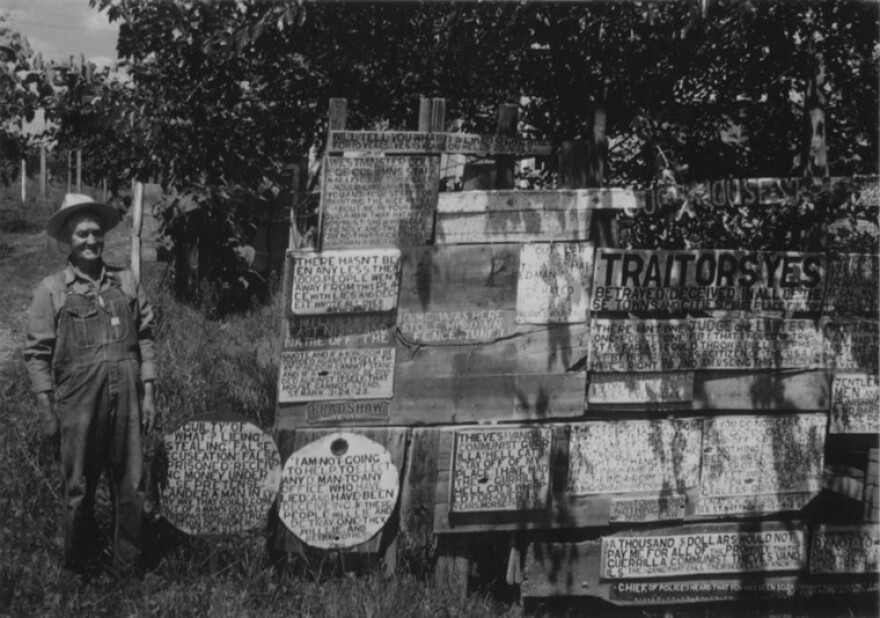Fulton, Missouri, is home to one of the most famous folk artists in the United States. Jesse Howard’s work hangs in the Smithsonian, but Fulton only recently started acknowledging the lasting impact his artwork has had on the country and the town.
Jesse Howard settled in Fulton in the early 1900s, on a farm outside of downtown. Howard almost always wore a uniform of bib overalls, work boots and a scrunched-up baseball hat.
There he began painting signs with any materials he could find, usually repurposed wood and sheet metal. He would write his thoughts on faith, the evils of the government and the corruption of the townsfolk in big, bold lettering. He would cite Bible verses, telling people to read the Book of Job to understand his plight.
He was especially worried about the growing presence and power of communists, which he wrote about on his signs. Anyone could be a communist to Howard: a doctor who charged him too much, a lawyer who didn’t support him, a sheriff who passed him by.

“It was almost like performance art, writ large across his property. It was all his showcase,” said Tom Riley, the president of a Fulton non-profit called The Art House and local Howard historian.
The signs were everywhere on his property, hung haphazardly on top of each other, an eyesore to anyone who drove by in their cars. These signs did not make Howard the most popular person in Fulton.
Fulton native Jana Oestreich said she remembers driving past Howard’s property as a teenager.
“He never, ever did anything scary to us, he just looked like a scary man to us, and we always kinda sped past,” said Oestreich.
Oestreich isn’t sure why she was scared of Howard.

“I’m sorry that we thought that about him when I think back now. It was wrong of us,” said Oestreich.
Fear was a common reaction to Howard and the signs he created. At one point the town was so fed up with Howard they came together to try to send him to a local mental hospital. The police stopped coming to Howard’s property when he would complain about his signs being stolen by fraternity members from Westminster College. The town’s reactions to Howard didn’t stop him from creating signs, though, and in many cases fueled him to create even more.
Not everyone was afraid of Howard. Barbara Binger moved to Fulton in 1967 with her husband, when Howard was in his 80s. She said she remembers being fascinated by Howard’s creations.
“We would take the children out, like on a Sunday drive, and go really slow and sometimes stop to read all the signs that he had,” said Binger.
Everything changed when Howard was profiled in an art magazine called Art in America in the 1960’s. Howard and his artwork were soon mentioned alongside artists like George Bingham and Grandma Moses. People started traveling from all over the country to visit his property and see his artwork, although this newfound fame hadn’t been Howard’s intention.

“He wasn’t trying to fit into the artistic world of the day, or get his work hung on gallery walls. He was purely expressing himself,” said Danielle Warren, an artist who owns a framing business in Fulton.
Howard gave tours of his property until his death in the 1980s. After his death, the Smithsonian acquired some of his pieces for a folk and self-taught art exhibit, an exhibit that has featured Thornton Dial Sr., Herbert Waide Hemphill Jr. and Malcah Zeldis.
Fulton never publicly acknowledged Howard or his artwork until this October, when a local non-profit called The Art House hosted the first-ever exhibition of his work in Fulton. Mark Stevenson, a musician from Kansas City, performed songs based on Howard’s artwork for the exhibition. He has a full album of songs based on Howard’s signs.

Most of the artwork in the exhibition was owned by Fulton residents. Binger donated a cross to the exhibit and said she was glad to see Howard getting recognition for his artwork, although not everyone understood it.
“I mentioned to a couple of friends that I had a piece or two that was gonna be in it, and one of them said, “That crazy old man?”,” said Binger.
There is still a lot to unpack from Howard’s artwork.
“It is not someone who just sat back and painted something beautiful or easy to consume. He was contradiction upon contradiction, and that’s what makes it interesting,” said Riley.

The exhibition in October was a reminder that Fulton is only just beginning to understand Howard’s impact on life in the town.
“I can’t characterize what his legacy is any more than saying, you know, fifty years later we’re still gonna be talking about him,” said Riley.
For now, Howard’s signs stand as a timeless reflection of one man’s beliefs and complicated relationship with the place he called home.
Special thanks to Travis Smith, Rebecca Ogus, Kara Tabor and Stephen Dawson for their assistance re-creating Howard’s signs in the audio story.


